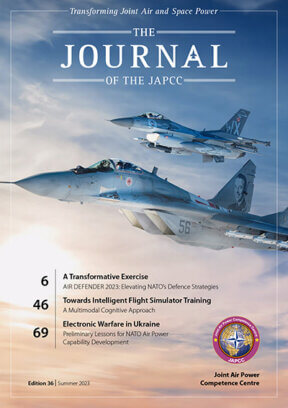Introduction
The Russian Federation has invested heavily in Cyber and Electronic Warfare (EW) since the 2008 military reforms as an asymmetric response to NATO military capabilities that depend on sophisticated electronic systems.1 However, Russia has not fully capitalized on this investment during the current invasion of Ukraine. This paper highlights some key issues and offers recommendations for EW capability development to improve the survivability and effectiveness of NATO air operations in highly contested environments. This paper is based on a presentation delivered by the author at the NATO Integrated Air & Missile Defence conference hosted at the Italian Air & Space Operations Command in Poggio Renatico on 23 March 2023.
Electronic Warfare During the Initial Invasion
During the initial invasion, the VKS (Vozdushno-Kosmicheskiye Sily; Russia’s Aerospace Forces) conducted intensive attacks on Ukraine’s Ground-Based Air Defences (GBAD), using a combination of cruise and ballistic missile strikes and anti-radiation weapons. Russia’s invasion force also included its largest combat deployment of EW capabilities to date.2 Russian electronic attack systems and aerial decoys jammed and confused Ukraine’s air defence radars, many of which had to be taken offline and relocated.
Despite these combined kinetic and non-kinetic attacks on Ukraine’s GBAD network, the Ukrainian Air Force (UAF) managed to prevent the VKS from gaining air superiority. This is a remarkable achievement, since the UAF pilots were significantly outnumbered by the VKS, who operate far superior combat aircraft equipped with better weapons, sensors, and EW systems, and were supported by airborne early warning platforms and space-based capabilities. Ukrainian aircrew also faced the persistent threat of Russia’s strategic Surface-to-Air Missile (SAM) systems, including SA-21s deployed in Belarus and Crimea.3
Whilst these threats imposed significant tactical constraints, the UAF quickly adapted their tactics to survive and remain effective in this high-threat environment. By flying at very low altitudes, below 100 ft in some cases, the UAF pilots were able to hide below the radar horizon of Russian SAMs, using ground clutter and terrain masking to avoid detection, before popping up to engage VKS fighter aircraft.4
Russia’s Command and Control Issues
Significant weaknesses in command and control compounded Russia’s inability to gain control of the air. A lack of planning and preparedness, coupled with procurement and encryption key distribution issues, forced many units to use civilian handheld radios and mobile phones, instead of secure, jam-resistant tactical radios.5
Ukrainian EW forces exploited these weaknesses by eavesdropping on Russia’s unencrypted transmissions, jamming their communications, and performing targeting for long-range weapons using direction-finding techniques.6 Ukrainian EW forces also used electronic attack capabilities to degrade the performance of VKS’s airborne early warning platforms, and one of these aircraft was sabotaged in Belarus with an Unmanned Air System (UAS) attack.7
Russia’s command and control issues hindered their ability to conduct joint air and land operations, and to make real-time tactical decisions in the battlespace. Additionally, the failure to de-conflict EW activities with the rest of their operations led to unintentional jamming of their own forces. The resultant confusion and disruption caused by this electronic fratricide led Russia to scale back its electronic attack efforts, thus enabling Ukrainian GBAD to become more effective.8
VKS’s Vulnerability to GBAD
Once Ukraine’s GBAD network recovered, much of the VKS’s aircraft were also forced to fly at low altitude to avoid being shot down by Ukrainian medium and high-altitude SAM systems. Consequently, VKS aircraft came directly within the engagement envelopes of large concentrations of Ukrainian short-range air defence (SHORAD) systems. Ukrainian forces inflicted heavy losses on low-flying Russian fixed-wing aircraft and helicopters, primarily using Man-Portable Air Defence Systems (MANPADS), including the US Stinger, the Russian Igla-series, and the more sophisticated laser-guided UK Starstreak, which cannot be defeated by conventional countermeasures.
Witnessing Russia’s heavy losses serves as a stark reminder of the threat posed by GBAD and the proliferation of MANPADS in particular. Platform EW protection capabilities, including Radio Frequency (RF) and Infrared (IR) countermeasures, will remain vital to safeguard NATO aircraft. The proliferation of MANPADS is set to continue, with nations such as China now actively competing with Russia for global exports. China has learned through reverse-engineering foreign weapons and has continuously upgraded and improved the performance of its indigenous systems. For instance, the FN-6 is a reverse-engineered copy of the European Mistral missile system.9 However, the FN-6 is equipped with an upgraded digital infrared seeker for improved targeting and resistance to countermeasures, such as flare rejection.10
There is also evidence of a significant rise in the proliferation of advanced Chinese MANPADS in the hands of violent extremists and other non-state actors. For instance, in 2014, ISIL/Daesh operatives in Syria and Iraq were equipped with the FN-6, in addition to various Russian-origin MANPADS.11 This highlights an unquestionable need to develop and procure advanced laser-based Directed Infrared Countermeasures to safeguard NATO air operations against the growing MANPADS threat.
Air Superiority Cannot Be Assumed
Although Ukraine has successfully blunted VKS low-altitude operations, Russian Su-35 and Mig-31 interceptors operating at high altitude have shot down significant numbers of Ukrainian ground attack aircraft using long-range radar-guided missiles. This threat, compounded by the presence of Russia’s strategic SAMs, has led to a state of mutually denied air superiority.
Russia has improved the effectiveness of its EW operations since the initial invasion, with considerable success in countering Ukrainian UAS. Russian EW forces have also attempted to jam NATO ISR aircraft operating on the periphery of Ukraine’s border.12 Of greater concern are the aforementioned strategic SAMs deployed by Russia in Belarus and Crimea, which are holding NATO ISR aircraft at significant risk, in addition to harassment from Russian combat aircraft. Russian aircrew have already committed several unprofessional and dangerous acts against NATO ISR platforms; the risk of further aggression and miscalculation ending in tragedy must not be underestimated.13
In addition to procuring weapons from Iran and North Korea, Russia is receiving non-lethal military aid and satellite imagery from China.14 With President Putin having openly declared a ‘no limits’ relationship between the two nations, it is entirely possible that Russia could seek support from China to re-arm its military forces.
Ultimately, the crisis in Ukraine has demonstrated that, unlike the past two decades of counter-insurgency operations in the Middle East, control of the air cannot be assumed. Instead, we are seeing a return to conditions similar to those faced in Kosovo during Operation Allied Force, where NATO aircraft had to conduct operations in highly contested airspace.
NATO EW Capability Development Priorities
If a direct conflict were to emerge with Russia, NATO would need to fight hard to gain access, survive, and achieve air superiority. EW will be a key enabler, and NATO needs to develop a full spectrum of Suppression and Destruction of Enemy Air Defence (SEAD/DEAD) capabilities.
Air and Space-based ISR will remain vital to gaining intelligence on adversary air defences and informing the development of countermeasures. Mission planning, mission data, on-board defensive aids, and expendable active and passive countermeasures will be crucial to breaking the adversary’s kill chain and maximizing the survivability and lethality of NATO aircraft in future hostile environments. Finally, a plethora of offensive systems, including electronic attack and anti-radiation weapons, will be necessary to disrupt, deceive, and destroy hostile air defence networks.
Accelerating EW Capability Development
Time is of the essence and funding is often limited to flagship programmes. Therefore, NATO should seek to learn from and more fully exploit existing EW capabilities and new developments within allied nations. For example, Ukraine has captured several high-value Russian EW assets during the conflict, and is reported to have handed these over to allied nations for technical intelligence purposes.15 NATO should aim to make best use of the intelligence gained from these efforts to develop and update electronic countermeasures.
Additionally, the Royal Air Force (RAF) Rapid Capabilities Office is reported to be experimenting with low-cost autonomous air systems, designed to operate in swarms and use compact EW payloads to disrupt and confuse air defence systems.16 Furthermore, the RAF is integrating a Modular Air Platform Protection System onto crewed ISR platforms, which is compliant with the NATO Defensive Aids System (NDAS) standard and capable of integrating advanced RF and IR countermeasure systems to provide protection against a variety of threats.17
Doctrine and training are equally important to technology development and equipment acquisition. Cyber and Electromagnetic activities cannot be an afterthought; they must be tightly woven into joint force manoeuvre plans. Additionally, regular training in electronically representative environments will help allied forces to survive and remain effective in the presence of EW threats, such as those deployed by Russia in Ukraine. Further investment and strengthening of the NATO Joint Electronic Warfare Core Staff (JEWCS) is recommended to enhance their capacity to deliver this training across the Alliance. Specialist training will also be necessary to ensure that NATO aircrew develop proficiency in the tactics, techniques, and procedures required to work together and deliver complex kinetic and non-kinetic effects, such as those employed on SEAD/DEAD operations. However, given the proliferation of space-based SIGINT capabilities, NATO will need to consider novel means to conduct EW training in the live environment, coupled with greater use of secure synthetic facilities to prevent adversary intercepts.
Ultimately, whether it is safeguarding our aircrew or disrupting, degrading, and denying adversary situational awareness, communications, and targeting, Electronic Warfare will be the fundamental enabler to more survivable and effective NATO air operations in hostile environments in the future.












